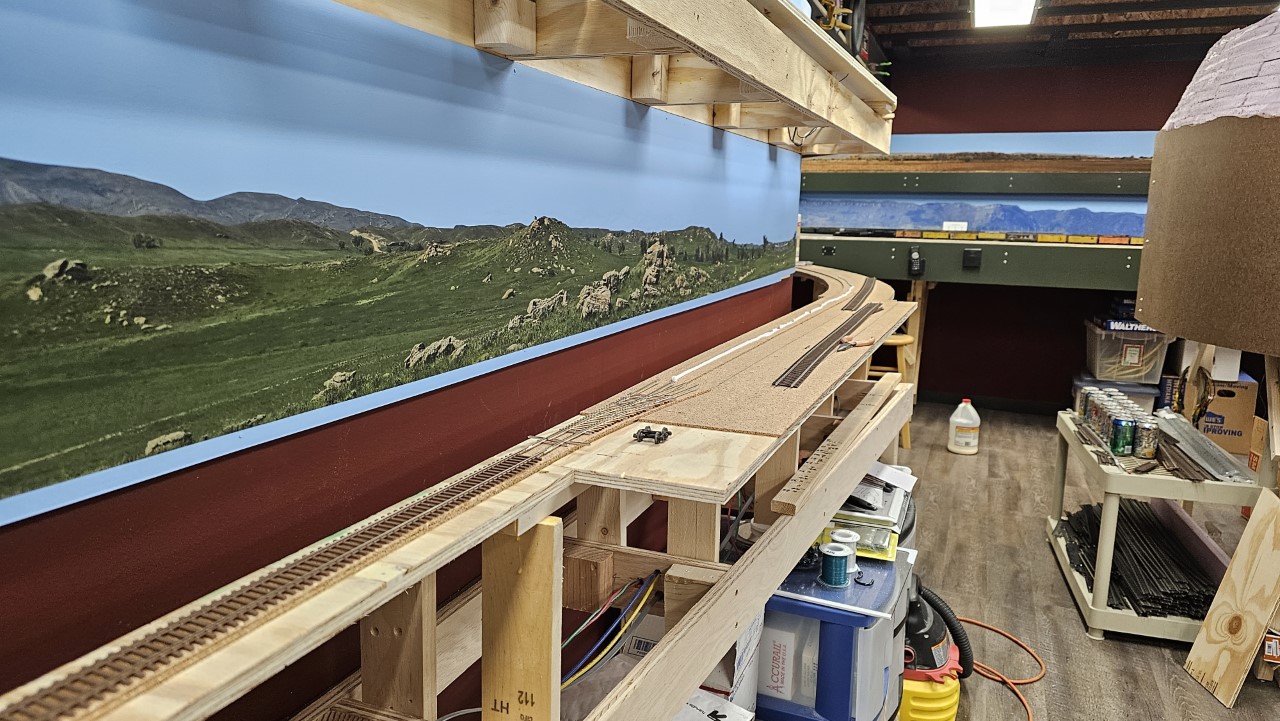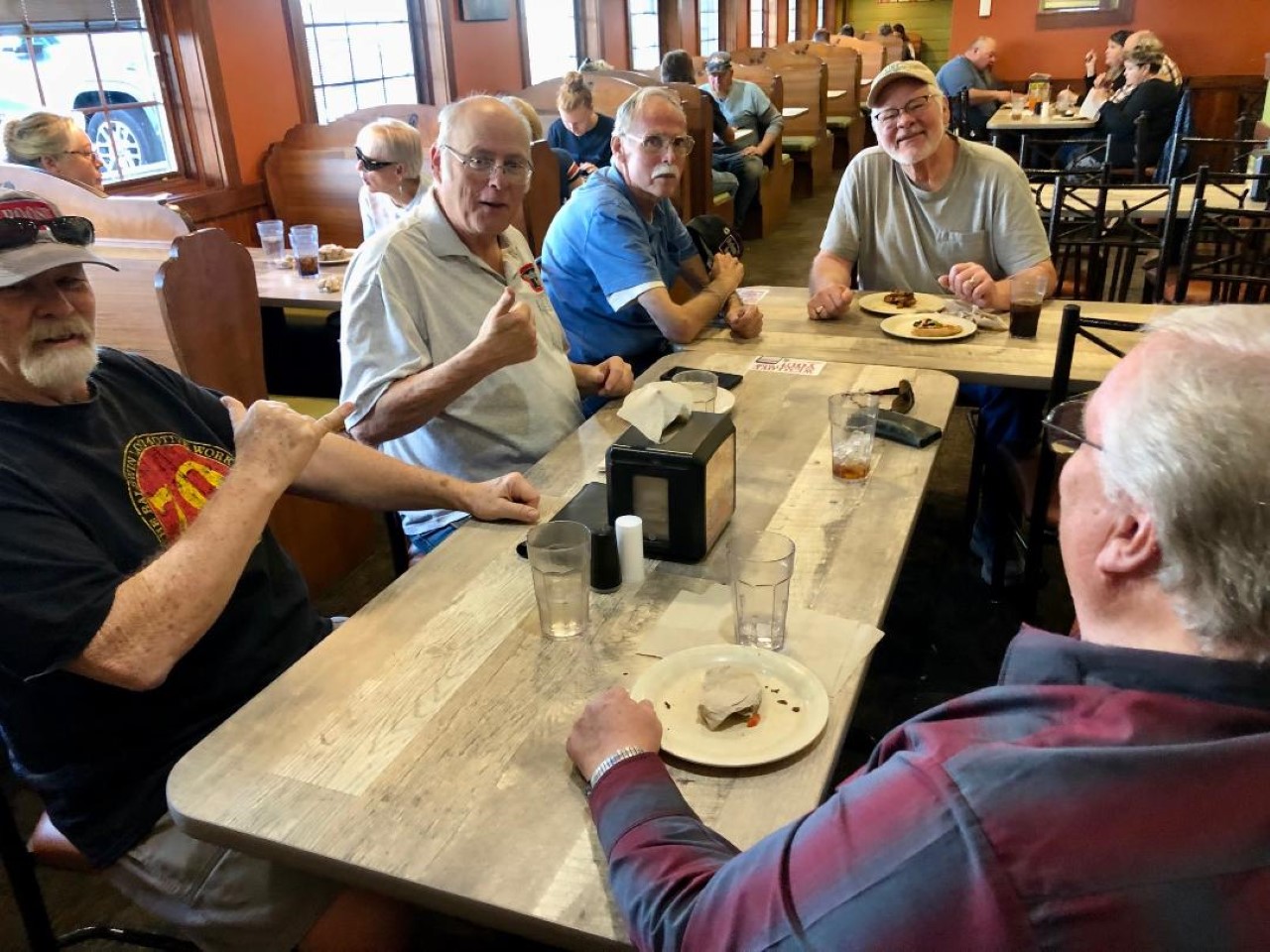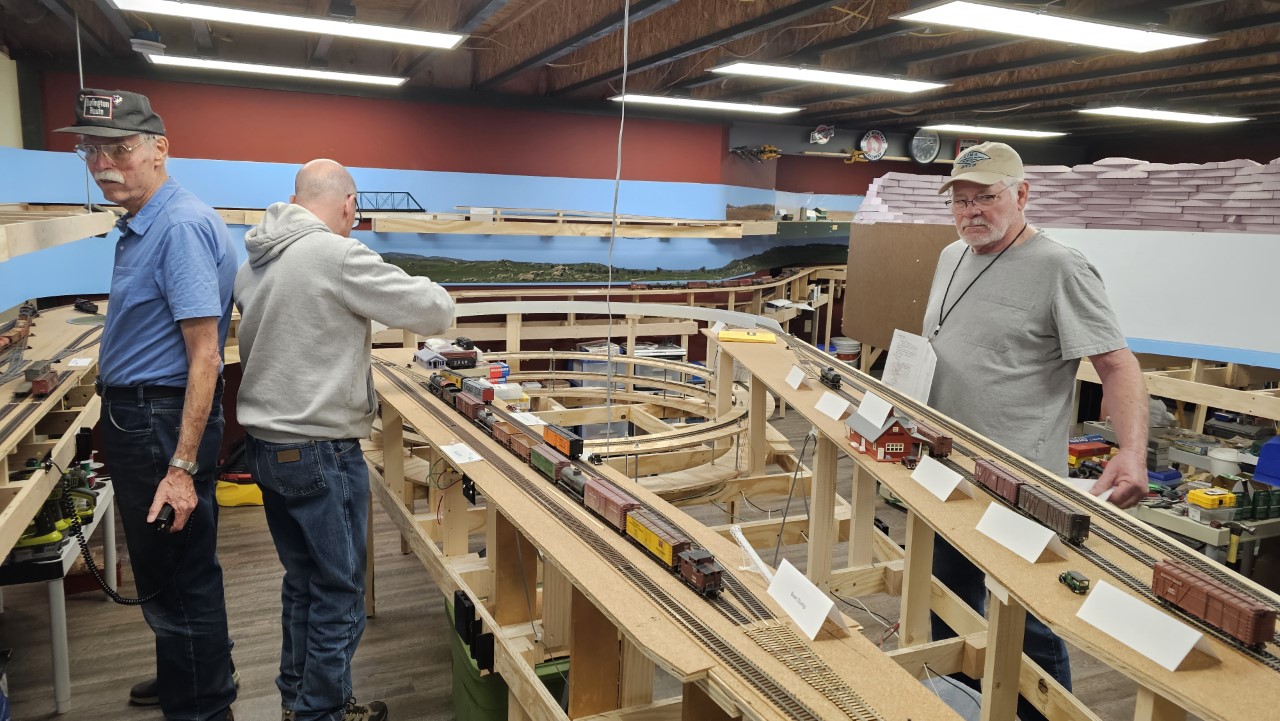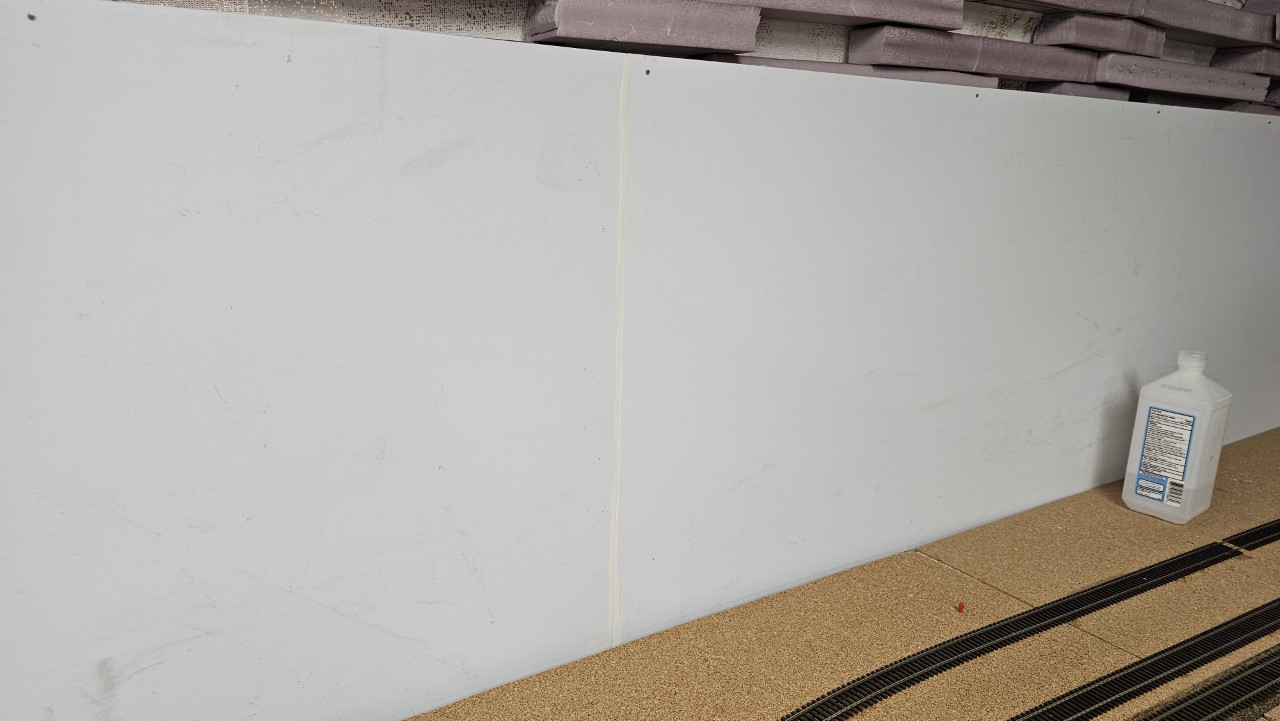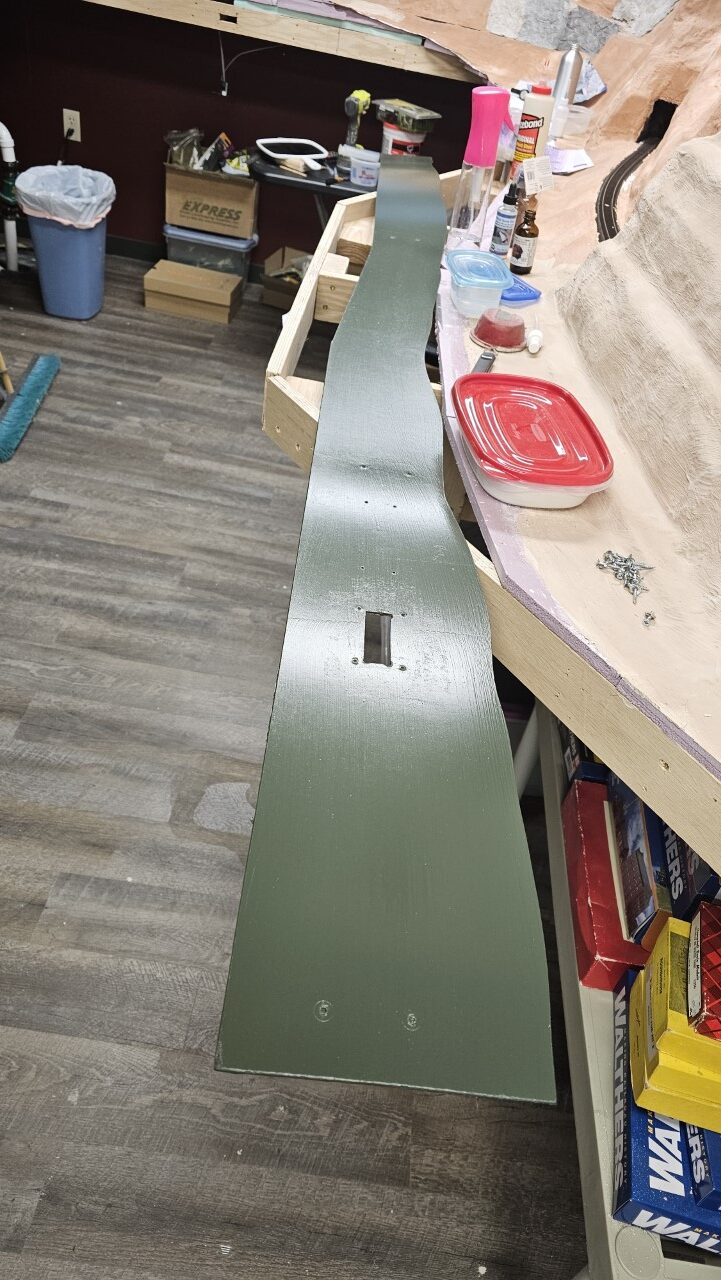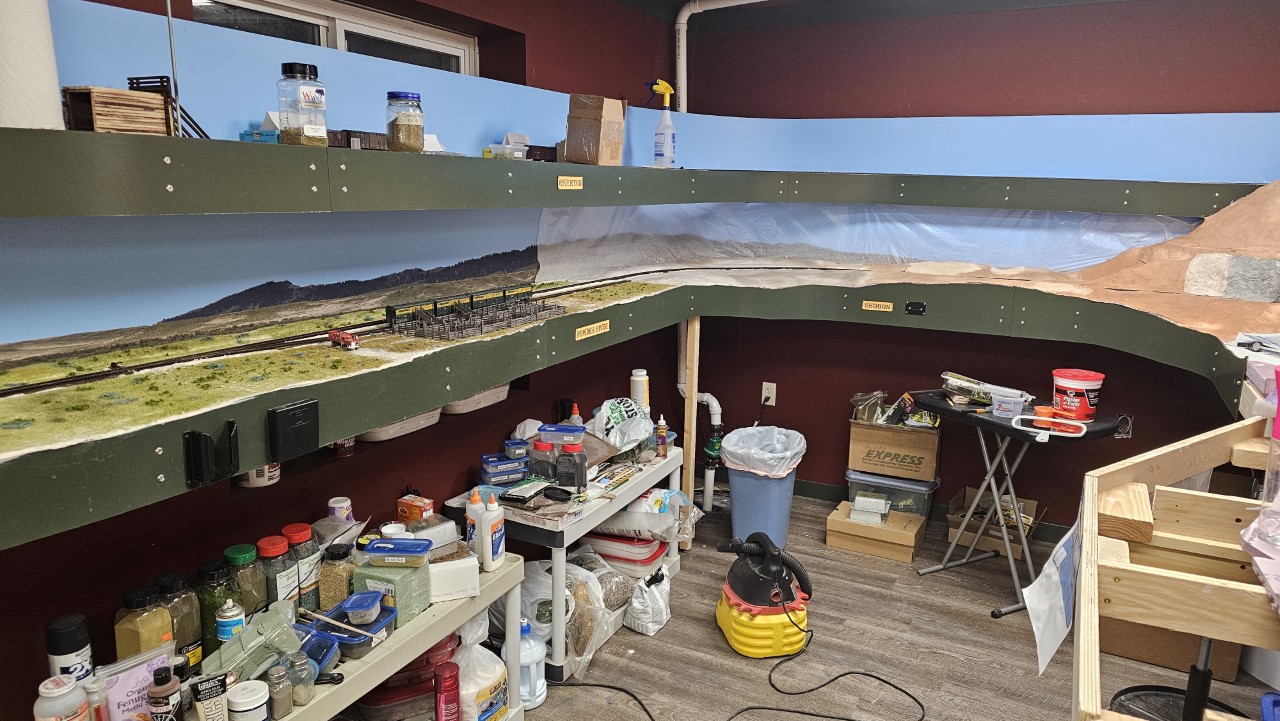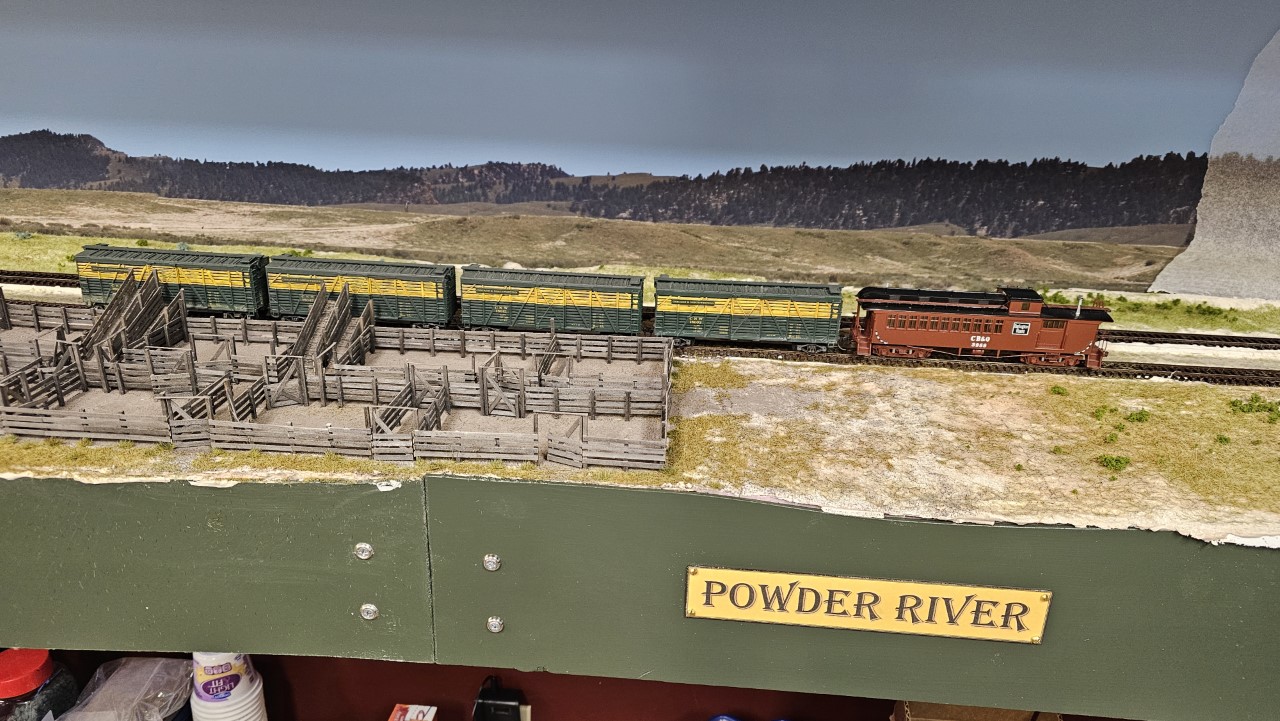Casper Construction Progress Part 4 – 2023 – October through December
10 October 2023
22 October 2023
26 October 2023
On October 24th I held my Autumn operating session. A few of the guys' wives came with them. All those that traveled to the session and were able to come early went out to lunch at Pizza Ranch before the session. Here, left to right, we have Kevin from Harriman, WY, about three hours away, Dave from Basin, WY, about 3 1/2 hours in the opposite direction, Steve from Evanston, WY, in the southwestern corner of the state about five hours away (he has his back to the camera), Johnny from Cape St. Francis, South Africa(!), about two days' flying time away, me, Bill from Sheridan, WY, about 2 1/2 hours north (Bill is the NMRA Northern Wyoming Division Superintendent), Debbie, Steve's wife, and Doris, Dave's wife. Juying, my wife, is taking the picture.
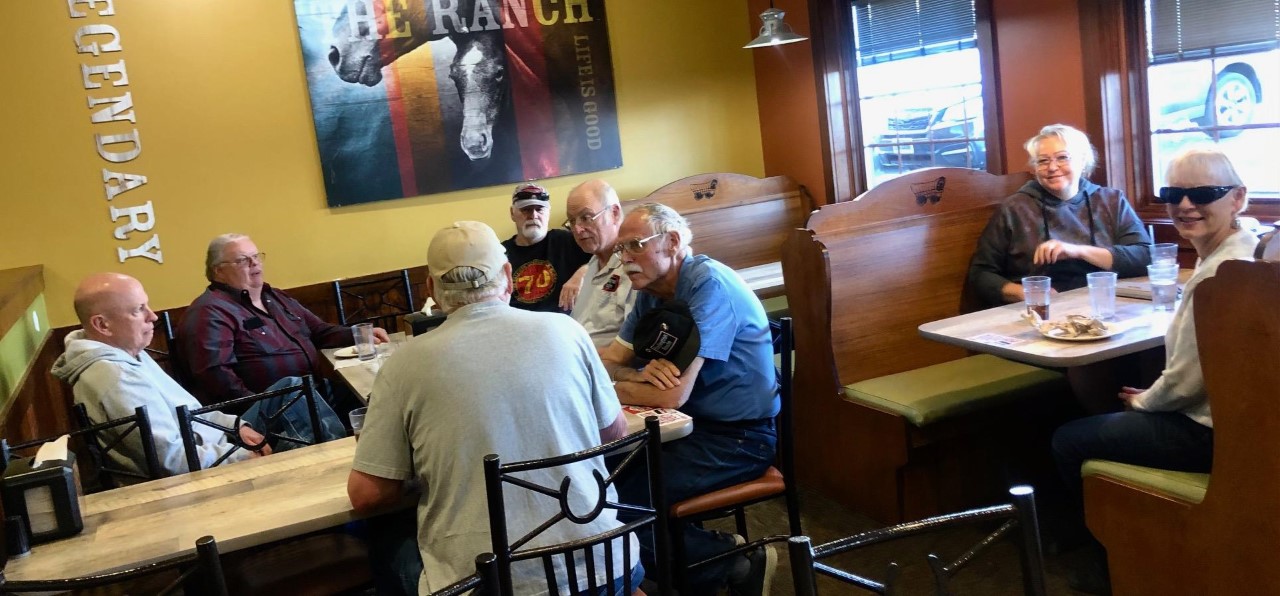
After lunch we headed over to the house and down into the train room in the basement (except for the wives - they went shopping).
Before we began the operating session I provided an overview of the layout. Here we're standing in the wide aisleway between Powder River and the Wind River Canyon, just beyond the Casper engine terminal. From left to right we have Johnny, who arrived on October 21st and stayed with my wife and I, Bill, Steve, yours truly and Dave.

Johnny, not knowing any better, agreed to be Casper yard operator for the session. Here he starting to break down the westbound reefer train to take it to the icing rack while Kurt, one of the local guys, is bringing his locomotive out of the engine facility.
Johnny proved to be a very accomplished operator and handled the rather demanding task of running Casper yard without a hiccup.

Bill took on the duties of Greybull yard operator. Like Johnny, he proved up to the task, building the two locals that service the Big Horn Basin towns, and coordinating the arrivals from and departures to east and west staging, all of which have to pass through Frannie / Greybull / Orin on their way onto and off the layout. Dave is watching Bill work, while Steve (partially behind the pole) is bringing the eastbound reefer express up from west staging.

Larry, who arrived a bit later in the session to take on the duties of the Casper local switcher, isn't in any of the photos I took on the 24th.
For the first time we managed to run all trains on the schedule.
The session was a great success. Everyone said they had a great time. Most of the long-distance folks headed for home by five in the afternoon, but Steve and his wife, who were in town for several days, and Johnny of course, stayed after the session for dinner and to visit. The next day we headed down to the Casper train club for a few hours, then Steve and Debbie headed back to Evanston. Johnny and I ran a few more trains that afternoon and again this morning. About 1 pm I took Johnny to the airport (in a dose of Wyoming autumn weather - a snow storm!) for the next leg of his world tour - a visit with his son in the UK, then back to South Africa.
Thanks for coming Johnny! We really enjoyed having you stay with us, and your participation in the ops session was a big help. Your suggestions for future sessions will be as well. I hope we can get together again one of these days!

13 November 2023
After the operating session I got right back to work on the layout. I started with Powder River's stock pens.
On 28 October, I gathered the materials needed to mix up some plaster to fill the gaps between the stock pens' base and the surrounding scenery. Here's how the pens looked sitting in the scenery. Note the gaps, especially the large one between the base and the fascia.

I needed to fill those gaps, and I figured I'd do it with plaster. But how to do that without spreading it all over everything?
I have several of these large syringes that are used to provide formula to folks who have a feeding tube. I've had these for years, from when my late was ill.
I realized I could mix up some soupy plaster and use the syringe to inject the plaster exactly where I needed it, with very little spillage.

I worked on other things for a weeks or so, then came back to the pens on 10 November.
I very carefully added new layers of dark brown dirt grout to the scene, making sure I misted on only a little water at a time. While it seemed to work okay, you can see how obvious the edges of the base still are. The grout doesn't fill much in at all!

The plaster had worked well, but I needed something else to smooth the edges and fill the small cracks left when the plaster cured and shrank a tiny bit. So I switched over to adhesive caulk. I laid a bead around three sides of the pens (ballast will cover the back side, which isn't very visible anyway).

26 November 2023
Dave came down from Basin to visit and help on the layout on November 22nd. We focused most of our efforts on scenery around the Powder River stock pens. I'd blended the dark earth of the pens into the surrounding lighter soils before that (didn't take a picture), so the area was ready for static grass and weeds. While we were adding the static grass I caught the fence with my applicator and popped it loose from the corner. The clamp is in place while the glue tacks up on the repair.
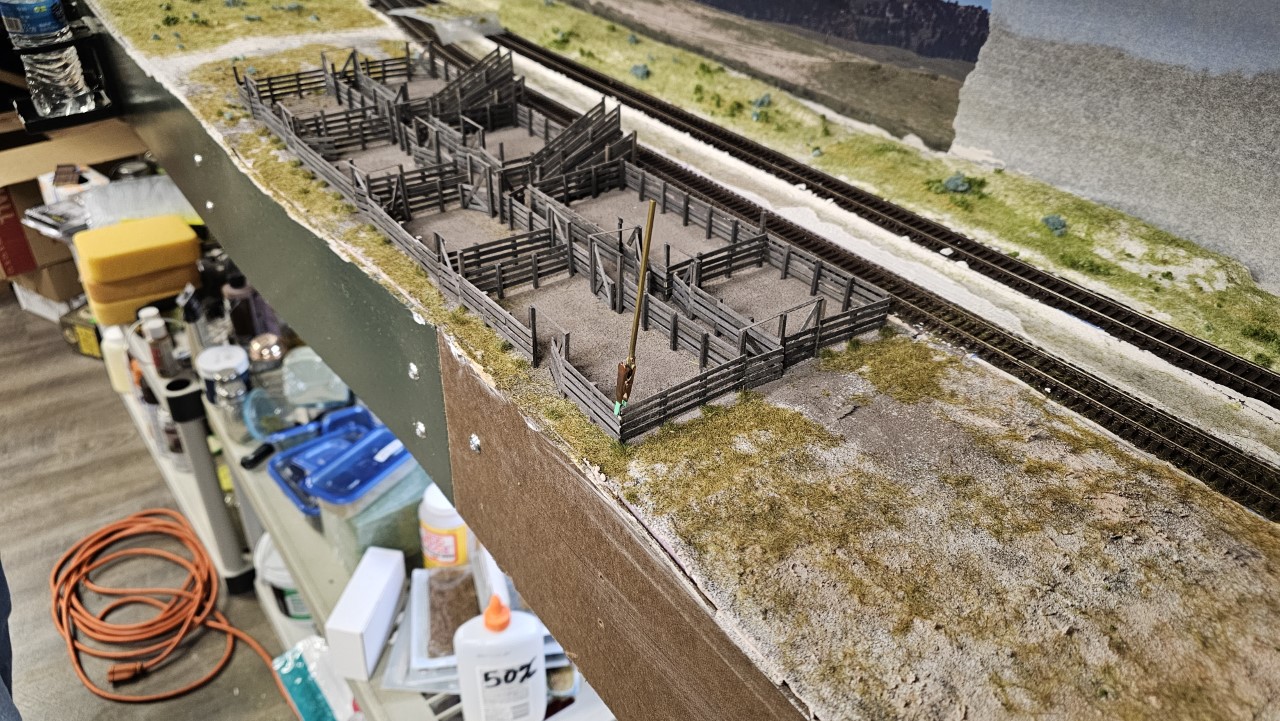
Since the 22nd I've turned my attention to renumbering the second of the Spectrum 10-Wheelers. Bachmann only produced one road number for CNW - number 236. Since the one is already weathered, I decided to renumber the one I bought earlier this year.
I did a bit of research into which 10-Wheelers worked in the Casper area, thinking that since I'm renumbering the loco anyway, I might as well number it for one that was actually around here. I found photos of half a dozen taken in Casper yard in the early 30's, and decided to renumber the model to 1395. Here's a couple photos of the prototype.

I decided on 1395 because it's the only one of the bunch that has the CNW logo rather than the loco number on sides of the tender. Sine the Spectrum tender has the logo on the tender sides, this saves me a bit of work. If I get anymore of these models (unlikely), I'll remove the logo from the tender.
I didn't want to remove the lettering below the area where the number had been if I didn't have to. I repainted the patch of missing paint with Vallejo black, skeptical that it would come out looking okay as I was brushing it on. I was right. Besides, I'd looked at the prototype photos, and saw that the lettering below the number was wrong anyway. The prototypes I have photos of all show a small "R1" (the class of the locomotives) under the number. So I flipped the loco over and removed all the paint on the entire panel under the cab on that side. This looked like a much better starting point for repainting / relettering.

On the 24th I applied the Vallejo black to the cleaned off area. The color is a pretty fair match to the rest of the locomotive, though there's some variation in the sheen. With the addition of gloss coat before the decals, then a dull coat afterwards, plus weathering of the entire locomotive, the area should match the rest of the locomotive just fine.

On the model the plate in the center of the smokebox front also carries the loco number. That would have been almost impossible to fix without damaging the very tiny lettering on the rest of the plate, so I opted to just paint over the number with black paint. It doesn't look very good in this shot, but the unevenness of the paint isn't even noticeable when looking at the loco on the layout.

11 December 2023
I built and weathered two hoppers. This first one is the tenth beet hopper from the series I built the other nine of this past January. I really don't like how those renumbering decals from Accurail look. If I do more renumbering of their cars I'll just use standard decals and remove the existing numbers first.

On December 3rd I posted my latest layout update video.
On the 5th I began assembling a couple of Walthers tank car kits - the ones that first appeared back in the 1990s. These were identical cars, both numbered 1595, so I needed to change the number on one of them.
I took the lazy way out and just removed the trailing "5" from one of the cars. This was easily done by scraping gently with an Xacto knife edge until the ink was removed.

Here's a photo of the two cars' underframes. If you look close at the lower one, you can see that I added a trainline. I took this shot to show the difference between having and not having the line. Afterwards I added the line to the top underframe as well.
The trainline isn't obvious at all, but it only takes a few minutes to do and it's an enhancement to the cars I know is there, even if no one else notices it.
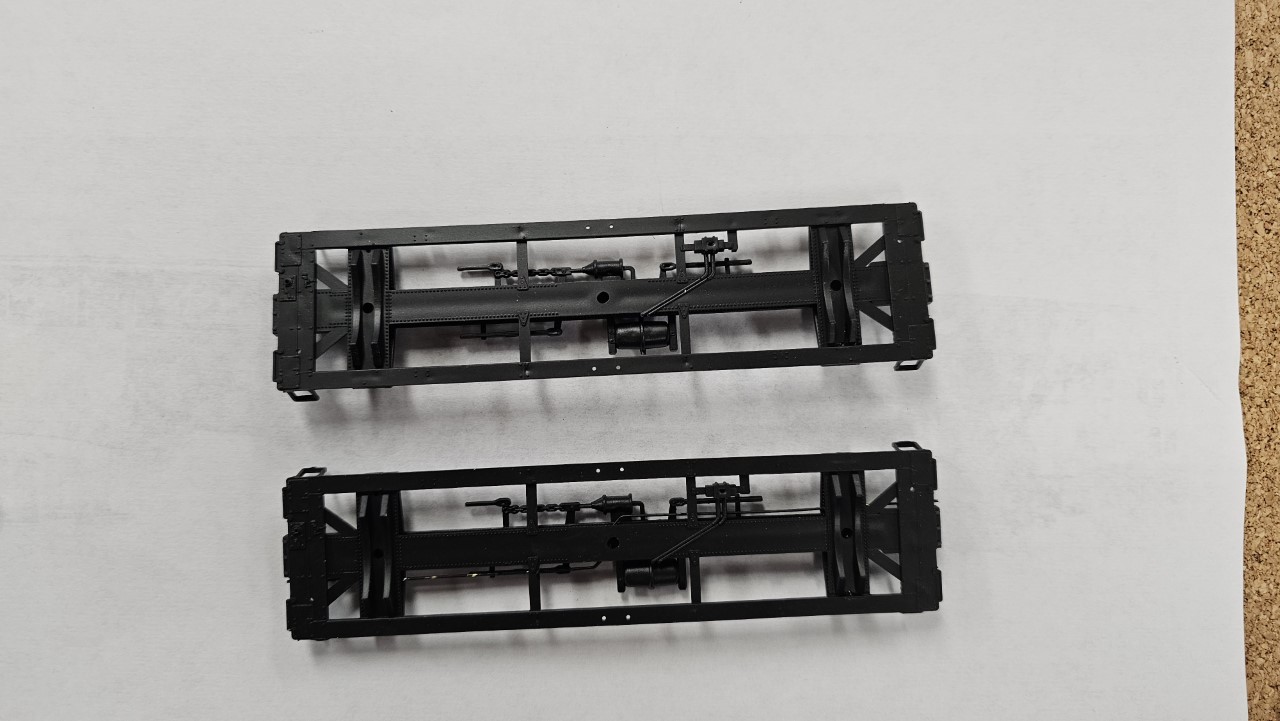
With the tank cars finished up I turned me attention to the fascia from Powder River to Shobon and in the Wind River Canyon. It was about time to put the finishing touches on some of that.
Here's how the fascia at Wind River Canyon looked when I started - the wax paper was there to keep the wet plaster from damaging the hardboard.
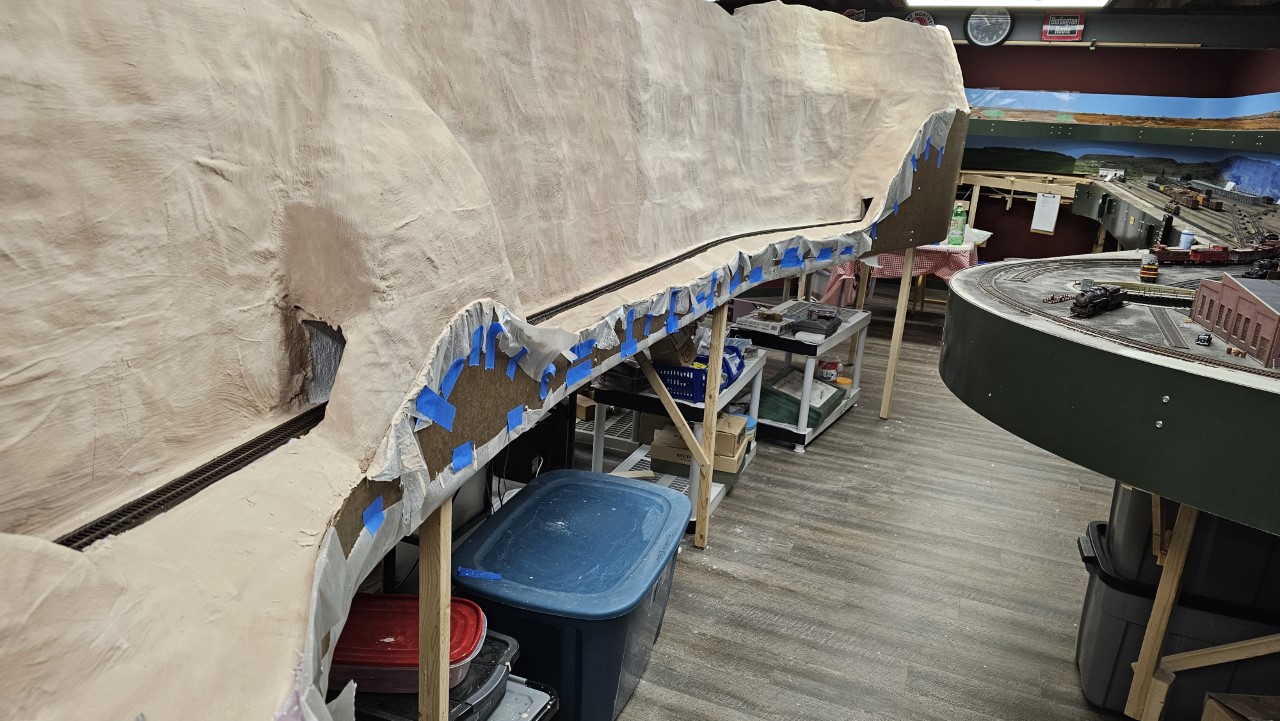
28 December 2023
On December 25th I posted my second annual Christmas Layout Tour.
One comment I got at the last operating session was that folks weren't always sure which directions were east and west. I spent some time in December working out some directional arrows, and have put the first couple together. Here's one of the ones for Casper. I still have to drill mounting holes and overspray the sign with Dullcote. This project will take quite awhile, because there are a couple dozen of these to make. I'll get the first few done, then they'll be something I'll work on between other projects.








